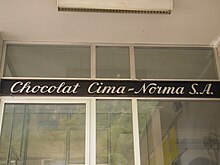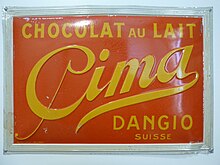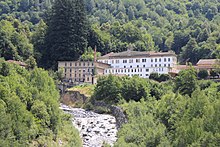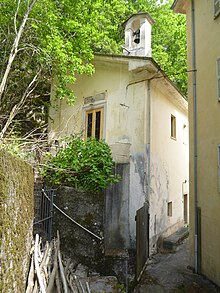Fabbrica di Cioccolato Cima Norma
The Fabbrica di Cioccolato Cima Norma SA , also Chocolat Cima-Norma SA in Dangio-Torre (today municipality Blenio ) was a company of industrial chocolate production of the canton in the alpine north of Ticino in Switzerland . It was founded in 1903 and had to cease operations in 1968. At the same time, the company Cima Norma SA stands for the goal of the beginning of the 20th century to promote the economic development and modernization of the Valle di Blenio mountain valley, which is classified as a peripheral region . The Cima-Norma SA presented all product categories ago; from chocolate powder to chocolate bars.
prehistory
The sparsely populated Blenio Valley, which in the past was traditionally characterized by subsistence-oriented forest, arable and pasture farming, viticulture in small plots and emigration, developed forms of seasonal emigration in the 18th century, in which even better-off families remained involved: in the seasonal change, moved the mostly male emigrants to the urban centers of Europe ( Paris , Milan , Pavia , Turin , Genoa , Lyon , Nice , Frankfurt am Main , Amsterdam etc.), where they offered sweets such as chestnuts or chocolates for sale. In the summer they mostly returned to their villages to take part in the agricultural work that was firmly in the hands of the women the rest of the year. Domestic agriculture was thus the backbone of this “dual family economy”. The monetary income from emigration, which could only be used to a limited extent for consumption in the barely commercialized economy of Ticino due to a lack of offers, flowed into new businesses. This enabled the establishment of permanent sales outlets or cafes, restaurants and hotels and the accumulation of specialist knowledge and investment capital.
The best-known example of such a success story is the curriculum vitae of Carlo Gatti (1817–1878), a businessman from Dongio in the Blenio Valley , whose restaurants and ice cream production brought him great wealth in England. The Cima family, who came from the municipality of Aquila (today the municipality of Blenio ) and partially emigrated to southern France, founded a chocolate factory in their valley of origin. Descendants of this long-established family, who had been wealthy since the 16th century at the latest, had founded their first chocolate factory in Milan around 1750 and took over factories founded by their compatriots around 1800 in Nice and around 1870 in Frankfurt am Main. In addition, the manufacturer Maestrani in Flawil, Switzerland, can be traced back to a chocolatier from the municipality of Aquila. These emigrants also founded the Giosia Luis, Hermano & Cia chocolate factory in distant Santiago de Chile in 1875 , which is now part of Nestlé Chile .
founding of the company
The brothers Roco, Clemente, Ernesto and Bernardino Cima, who had returned from Nice, founded the factory in Dangio-Torre in 1903, initially with nine employees under the name of Cima Frères in the former San Salvatore brewery , which was founded in 1879 and produced until 1905. However, due to numerous problems, they had to sell the company on May 19, 1913 to Giuseppe Pagani (1859–1939), who had already joined as an investor in 1908. Originally from Torre, Giuseppe Pagani had worked as a waiter in London since 1873, but then also made money in the hotel and restaurant business. In 1903 he sold his flourishing Pagani's Restaurant with a private artist room at 54 Great Portland Street - whose guests included Pyotr Ilyich Tchaikovsky , Giacomo Puccini and Nellie Melba - and left London. In Switzerland he invested in the Baumann und Cie. Chocolate factory in Adliswil near Zurich which is in liquidation . , with their Norma brand , whose inventory and customer base he acquired for 55,000 francs. He merged both companies in 1930 under the newly registered company Cima Norma SA . Since his father had run his own chocolate production in Milan for a long time, Pagani was familiar with the business. This development initiated an economic upswing in the Blenio Valley and temporarily led to a sharp increase in the resident population due to the influx of workers from surrounding valleys and neighboring Italy. In the period from 1913 to 1920, for example, the factory had 493 employees, 68.8% of whom had traveled from outside the valley. When choosing the unusual location, the numerous female workers who were underemployed in local agriculture also played a decisive role, as, in the absence of other options, they were often willing to work at extremely low wages. The foreign workers were under the supervision of Roman Catholic nuns, first the Menzing sisters and later the Rosminians . In accordance with the expectations of the time, the aim was to put a stop to “immorality”.
Another reason for choosing the location was that cocoa supplies from British West Africa had proven more reliable than imports from Latin America during the two world wars and in the interwar period . Such deliveries often got stuck in the Atlantic ports during the wars. That is why the proportion of West African cocoa rose rapidly in each of the crisis years and reached 84% in 1918 and 77% in 1944 of all cocoa imports into Switzerland. In order to be able to secure the coveted raw material at the source, several families from the neighboring municipality of Ludiano (today Serravalle ) were even willing to emigrate to the then British colony of Sierra Leone in the 20th century . The location of the factory on the transport route via the seaports in Italy therefore turned out to be a competitive advantage for the company. Due to its rapid growth, Cima Norma SA had become the most important beneficiary and major shareholder of the railway connection to the Blenio Valley ( Biasca-Acquarossa Railway ). The cocoa sacks, mostly arriving from Genoa, were transported by this private railway company from the point of loading in Biasca . The rest of the way was handled by our own Saurer trucks . Giuseppe Pagani was a co-founder of this railway and served as its chairman from 1906 and until his death. Francesco Antognini and Luigi Ferrazzini later took over the management of Cima Norma SA .
The rise and fall of the company
For a long time, Cima Norma SA was able to believe that its success was certain: in particular, the government protective measures and subsidies in the isolation years of the Second World War , which brought the company rich profits, had led to this assessment. In 1939, production peaked at around 1,500 tons. As part of the so-called war economy, Cima Norma SA supplied a large part of the Swiss army chocolate and was personally visited by General Henri Guisan in September 1941 . The rising consumer demand that began after the war, which easily absorbed the production of the manufacturers previously active in the market, as well as fixed purchase agreements with the large cooperative distributors Coop (at that time Schweizerischer Konsumverein Basel) and Usego reinforced an overly optimistic assessment of the situation. As a result, those responsible were hardly interested in innovation and in the changed customer requirements and lost touch with the increasing number of competitors. At the same time, personnel, raw material and logistics costs had risen steadily.
When Coop terminated the supply agreement with Cima Norma SA in August 1966 , the company suddenly lost almost two thirds of its sales. Other major buyers such as Volg , Végé Italiana and the sale of the cheaper own brand Tessinor in West Germany could not make up for the loss quickly enough. The attempt to diversify sales markets with new management staff and new ideas, as well as the layoffs that were carried out immediately, could not save the company from the imminent closure, which was clearly apparent in spring 1968 and which occurred at the end of July 1968. With the decision to take this step, the management had just barely anticipated the impending bankruptcy. The layoffs did not meet with any noteworthy resistance from the population, because the majority of those affected were recently housewives who were employed part-time and hardly any unionized guest workers. The decline of Cima Norma SA and the almost simultaneous cessation of spa operations in neighboring Acquarossa sealed the end of the rail connection to the valley: it was dismantled and replaced by a bus service. As a result, the population in the Blenio Valley continued to decline.
Aftermath
The factory and its workers repeatedly attracted the artistic interest of the photographer Roberto Donetta (1865–1932), who came from the Blenio Valley and was recognized for art history , who dealt with these people in several impressive series of portraits. In addition to their aesthetic value, the recordings also provide information about the social structure of the factory workforce.
The return of many prosperous emigrants from Europe and overseas led to the construction of stately villas, mainly in Olivone and in the southern municipalities of the Blenio Valley (Semione, Ludiano and Malvaglia, today municipality of Serravalle ). In particular, they give the village of Semione, which is embedded in the rural-alpine surroundings, an urban-chic appearance. The village was therefore included in the “ Federal inventory of Swiss sites of national importance worthy of protection ”. The widespread knowledge of French and English among the older population of the valley is also a legacy of this period.
The imposing third production building of the Fabbrica di Cioccolato Cima Norma SA , built with a claim to representation and aesthetics , which was built after severe natural damage to the two previous buildings and has its own workers' apartments (“Pensione per Operaie”), a factory chapel and its own, The town of Dangio-Torre, which has barely grown since then, dominates the townscape to this day, powered by the hydropower of the Soia river . The structure was designed by the engineer Alfonso Zoppi (1879–1942) from 1917. Zoppi was also involved in the construction of the Biasca-Acquarossa railway , which he managed from 1910 to 1917. In the cemetery of Torre, the mausoleum of Giuseppe Pagani can be visited, which is decorated with marble reliefs on the outside and an elaborate ceiling mosaic on the inside. It was built in 1930 based on plans by the architect Enea Tallone (1876–1937). Another architectural legacy is the Villa Pagani (also: Villa Lina ), by the architect Giuseppe Martinoli, from 1897, with riding stables from 1904. Even the sons-in-law entrusted with the management after Giuseppe Pagani's death had their own villas built ( Villa Antognini , Villa Ferrazzini ). Numerous production rooms are now open to the public. An exhibition shows the history of the Cima Norma.
The further use of the production and residential buildings was unclear for a long time. Parts of the approximately two dozen individual buildings have so far been used by local small businesses and occasionally as accommodation for the Swiss Army. In 1992 a comprehensive study was carried out by architects and students from the Southern California Institute of Architecture - offshoot in Vico-Morcote - about the possibilities of converting the factory into a cultural center with living, recreation and work spaces, including a restaurant. The project presented by the architects Martin Wagner and Lars Lerup could not be implemented due to a lack of financial resources. The Ticino architect Marino Venturini, who tried to preserve the buildings, acquired the disused industrial site and 87% of the share capital from the Antognini family, the descendants of Giuseppe Pagani , on March 13, 2009 .
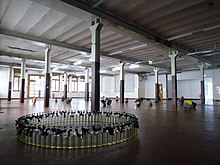
The successor of Cima Norma SA , which was registered in the commercial register of the Canton of Ticino mainly as a real estate company in January 1972 , received new statutes for the first time in 1997. In 2017, a brand of the same name was finally relaunched as a nostalgic reminiscence of the Belle Époque together with Chocolat Stella Bernrain as a “private label”. The Fondazione La Fabbrica del Cioccolato was set up in November 2015 with an entry in the commercial register . She has set herself broad goals in the areas of culture and education, for which she mainly wants to seek cooperation with domestic and foreign cultural and educational institutions. The foundation was recently averted bankruptcy proceedings due to outstanding wage payments and unpaid orders to artists and craftsmen . Although La Fabbrica del Cioccolato took over financially in its initial phase, it seems to have stabilized afterwards, as it enjoys the support of the Tessiner Kantonalbank and the ERSBV, an organization that promotes economic development in the Tre Valli. It offers space and seclusion for changing artists in residence and is supported by the contemporary artists Lea Loeb, Lukas von Blarer, Maximilian Stern, Stefan Breit and Jessica Huber from the artist group Re / fugium from Zurich and the curator Franco Marinotti.
literature
- Federico Bruni: I cioccolatieri dall'artigianato all'industria . Istituto Editoriale Ticinese, Bellinzona / Lugano 1946.
documentary
- Maren Niemeyer : 100 percent chocolate, the history of the Swiss chocolate factory Cima Norma, documentation. ARTE , Germany 2006, 60 min.
Web links
- History of the Cima-Norma (it.)
- History of Cima-Norma on Vallediblenio.ch (it.)
- Fondazione La Fabbrica Del Cioccolato (it.)
Individual evidence
- ^ A b Marco Marcacci, Fabrizio Viscontini: La Valle di Blenio e la sua Ferrovia - L'ingresso nella modernità . Ed .: Autolinee Bleniesi SA 1st edition. Salvioni Edizioni, Bellinzona 2011, ISBN 978-88-7967-283-2 , p. 37 ff., 94 .
- ↑ a b c d e f g h i j k Patrizia Pusterla Cambin, Valentina Foni: L'oro bruno - Cioccolato e cioccolatieri delle terre ticinesi . Museo storico etnografico di Blenio , Lottigna 2007, ISBN 978-88-87278-77-4 , p. 48-70, 77 f., 98, 113 ff., 116, 146 .
- ^ André Holenstein, Patrick Kury , Kristina Schulz , et al .: Swiss Migration History - From the Beginnings to the Present . Hier und Jetzt, Verlag für Kultur und Geschichte, Baden 2018, ISBN 978-3-03919-414-8 , p. 77 .
- ^ Daniela Pauli Falconi: Gatti, Carlo. In: Historical Lexicon of Switzerland , accessed on February 25, 2018 .
- ^ Felicity Kinross: Coffee and Ices - The story of Carlo Gatti in London . (Self-published [?], Print: Lavenham Press), 1991, ISBN 0-9517745-0-6 , p. (Monograph) .
- ^ Sonia Fiorini: Blenio (district). In: Historical Lexicon of Switzerland , accessed on February 25, 2018 .
- ^ A b Daniela Pauli Falconi: Cima. In: Historical Lexicon of Switzerland . March 8, 2017. Retrieved February 25, 2018 . (Family [author's note]).
- ↑ Patrik Luis: Storia dell'emigrazione in Cile di Giosia Luis (1850-1918). In: vallediblenio.ch. Ed .: Gabriella Zacek, Mara Maestrani-Zanetti, accessed on May 31, 2019 (Italian).
- ↑ a b c Sima Farroki Tami: Cioccolata amara. Fabbrica di cioccolata Cima Norma in Val di Blenio: un passato chiuso, un futuro aperto. In: Archi. Rivista svizzera di architettura, ingegneria e urbanistica. 2001, accessed on March 2, 2018 (Italian / English).
- ↑ a b Luca Solari: Blenio: una valle a confronto . Salvioni arti grafiche, Bellinzona 1998, ISBN 88-7967-023-9 , p. 122, 127 .
- ↑ a b Thomas Blubacher: Instructions for use for Ticino . Piper Verlag, Munich 2019, ISBN 978-3-492-27723-5 , pp. 86 .
- ↑ Hans-Peter Bärtschi: Cima Norma - the largest factory in the Blenio Valley . In: IN.KU . No. 25 . Swiss Society for the History of Technology and Industrial Culture , Winterthur September 1998.
- ↑ Marco Marcacci: Pagani, Giuseppe. In: Historical Lexicon of Switzerland , accessed on February 25, 2018 .
- ↑ Marco Marcacci, Fabrizio Viscontini: La Valle di Blenio e la sua Ferrovia - L'ingresso nella modernità . Ed .: Autolinee Bleniesi SA 1st edition. Salvioni Edizioni, Bellinzona, Bellinzona 2011, ISBN 978-88-7967-283-2 , pp. 34 ff .
- ^ Roberto Donetta (photographer): Gruppo di operaie della Cima Norma davanti all'economato. Fondazione Archivio Fotografico Roberto Donetta, Corzoneso, accessed on February 25, 2018 (Italian).
- ^ Roberto Donetta (photographer): Gruppo di operaie della Cima Norma davanti all'economato. Fondazione Archivio Fotografico Roberto Donetta, Corzoneso, accessed on February 25, 2018 (Italian).
- ^ Roberto Donetta (photographer): Gruppo di operaie della Cima Norma; quarta da sinistra in prima fila: Maria Perani; ultima fila: seconda da sinistra Antonietta Donetta; quarta Anna Cizzio. Fondazione Archivio Fotografico Roberto Donetta, Corzoneso, accessed on February 25, 2018 (Italian).
- ↑ Andrea Franc: How Switzerland came to chocolate - The cocoa trade of the Basler Handelsgesellschaft with the Gold Coast colony (1893–1960) . Ed .: S. Burghartz, et al. 1st edition. tape 180 . Schwabe Verlag, Basel 2008, ISBN 978-3-7965-2409-7 , p. 173-182, 247, 288 f. (Annex) .
- ↑ Marco Marcacci, Fabrizio Viscontini: La Valle di Blenio e la sua Ferrovia - L'ingresso nella modernità . Ed .: Autolinee Bleniesi SA 1st edition. Salvioni Edizioni, Bellinzona 2011, ISBN 978-88-7967-283-2 , p. 34 .
- ^ A b c Marco Marcacci, Fabrizio Viscontini: La Valle di Blenio e la sua Ferrovia - L'ingresso nella modernità . Ed .: Autolinee Bleniesi SA 1st edition. Salvioni Edizioni, Bellinzona 2011, ISBN 978-88-7967-283-2 , p. 135 ff .
- ^ Antonio Mariotti (presidente), et al .: Le fotografie di Roberto Donetta. In: Archivio Fotografico Roberto Donetta. Fondazione Archivio Fotografico Roberto Donetta, Corzoneso, accessed on February 25, 2018 (Italian).
- ↑ Bettina Wohlfender: Roberto Donetta. In: Directory of Photographers. Office for the History of Photography, Bern, accessed on February 25, 2018 .
- ↑ Federal Office of Culture: List of sites of national importance: TI: Semione. Retrieved March 2, 2018 .
- ^ Roberto Donetta (photographer): Fabbrica di cioccolata Cima Norma. Fondazione Archivio Fotografico Roberto Donetta, Corzoneso, accessed on February 25, 2018 (Italian).
- ^ Roberto Donetta (photographer): Vecchia fabbrica di cioccolata Cima Norma a Dangio. Fondazione Archivio Fotografico Roberto Donetta, Corzoneso, accessed on February 25, 2018 (Italian).
- ↑ Maps and geodata. Federal Office for Topography swisstopo, Wabern near Bern, accessed on April 9, 2018 .
- ↑ Schweizerische Bauzeitung (ed.): Necrologist: Alfonso Zoppi, civil engineer from Airolo, born on January 3, 1879, ETH 1900/04 . tape 119 , no. 12 . Zurich 1942, p. 144 .
- ↑ Find A Grave , maintained by Robert Savary (contributor 48881410), Find a Grave Memorial no. 192135122: Giuseppe Pagani. August 10, 2018, accessed on August 14, 2018 .
- ^ Simona Martinoli: Enea Tallone. In: Historical Lexicon of Switzerland . May 23, 2012. Retrieved February 28, 2018 .
- ↑ a b Patrizia Pusterla Cambin: Sentieri Storici della Valle di Blenio . Bellinzonese e Alto Ticino Turismo, Bellinzona, S. 42 f .
- ↑ Florio Fogliani: Cima Norma, nel segno della continuità . In: Giornale del Popolo . Massagno March 14, 2009.
- ↑ Uwe Ramlow: 111 places in Ticino that you have to see . 1st edition. Emons Verlag, Cologne 2016, ISBN 978-3-95451-840-1 , p. 94 f .
- ↑ La Storia di Cima Norma. Retrieved April 5, 2018 (Italian).
- ^ Cima Norma SA. Commercial register office of the Canton of Ticino, accessed on April 5, 2018 (Italian).
- ↑ La Storia di Cima Norma. Retrieved April 5, 2018 (Italian).
- ↑ Excellent chocolates for private labels worldwide. Chocolat Bernrain AG, Kreuzlingen, accessed on July 18, 2018 .
- ^ Fondazione La Fabbrica del Cioccolato. Commercial register office of the Canton of Ticino, November 5, 2015, accessed on April 5, 2018 (Italian).
- ↑ Samantha Ghisela: Ex Cima Norma: con le ditte fatture scoperte per 100mila franchi. La Regione - Regiopress, July 21, 2018, accessed July 22, 2018 (Italian).
Coordinates: 46 ° 29 '32.3 " N , 8 ° 57' 20.1" E ; CH1903: seven hundred and sixteen thousand four hundred fifty-seven / 150124
